Sustainability in Project Portfolio and Program Management Report
VerifiedAdded on 2022/10/02
|21
|4830
|468
Report
AI Summary
This report evaluates the implementation of project portfolio management (PPM) within Richard Crookes Constructions, a family-owned construction company. It addresses resistance to PPM by highlighting its impact on business aspects, including project evaluation using the return on investment (ROI) method and change management via Kotter's plan. The report discusses current methods, stakeholder management issues, and the alignment of projects with strategic objectives, emphasizing the importance of portfolio evaluation, maturity levels, and corporate culture. It also examines the situational context, including the need for PPM, the organization's capacity, and the benefits of effective execution, such as increased efficiency and profitability. The report suggests methods like the Balanced Scorecard for alignment and the establishment of a Project Management Office to standardize practices. The report concludes by emphasizing the need for PPM implementation to ensure sustainable project outcomes.
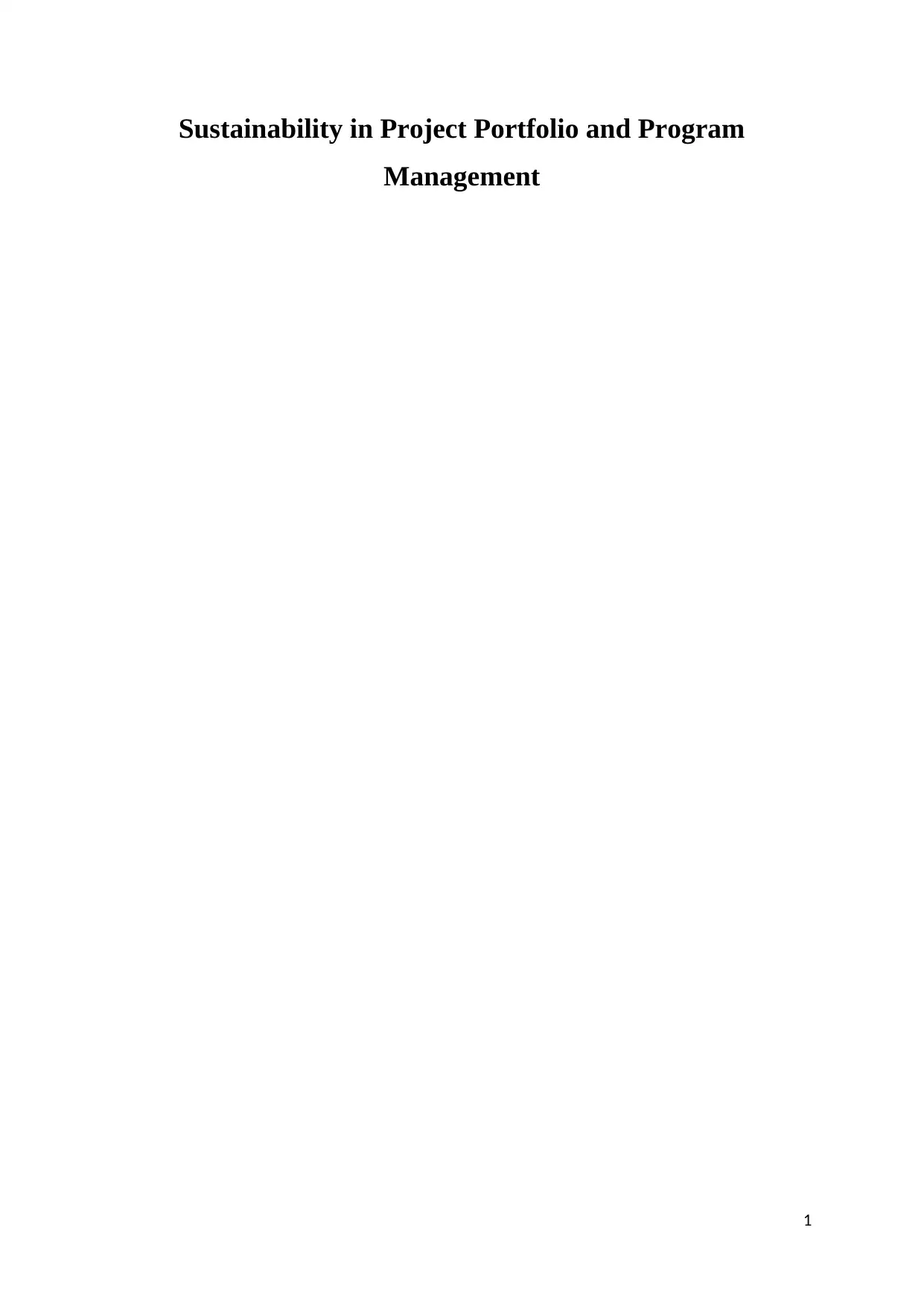
Sustainability in Project Portfolio and Program
Management
1
Management
1
Paraphrase This Document
Need a fresh take? Get an instant paraphrase of this document with our AI Paraphraser
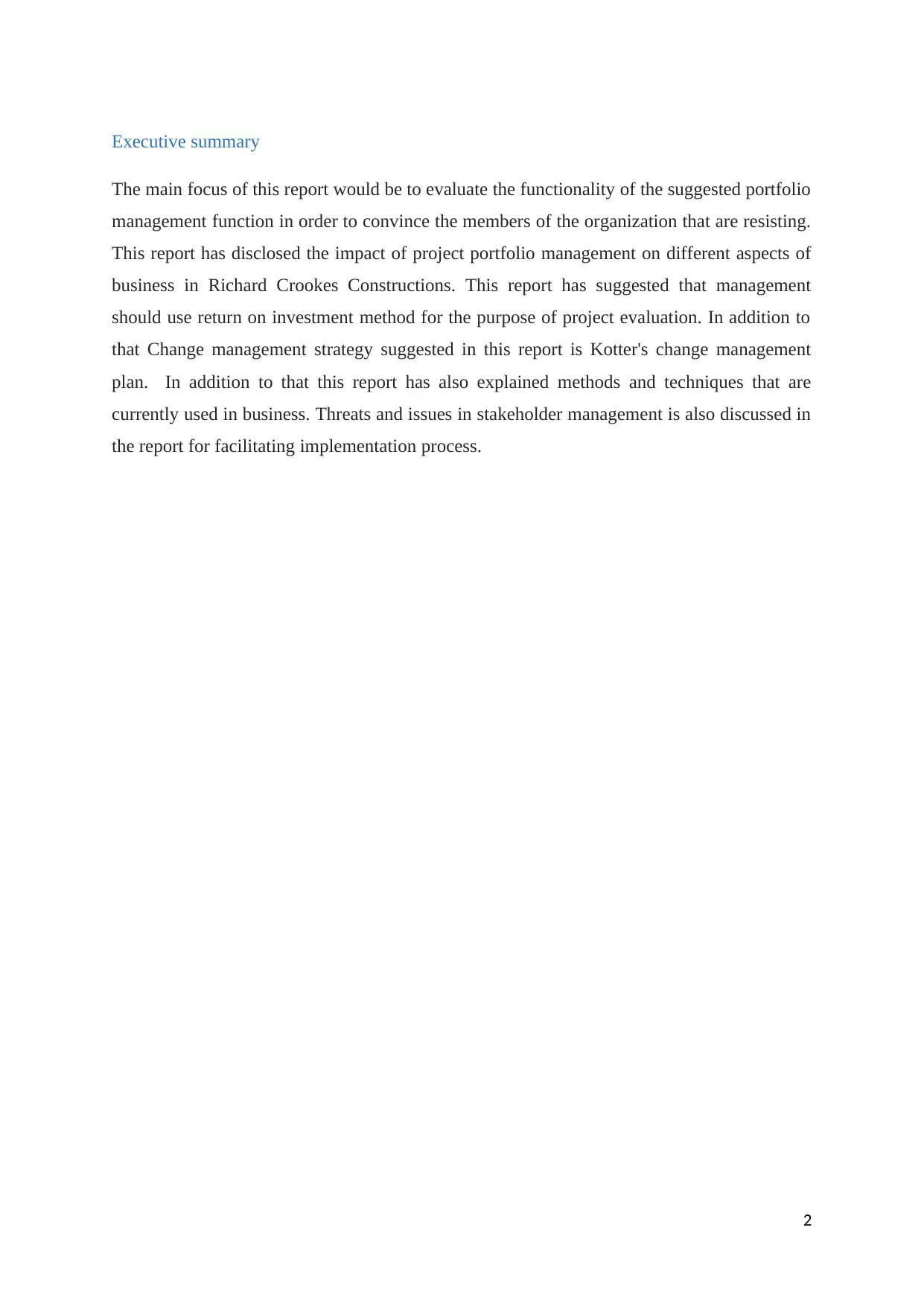
Executive summary
The main focus of this report would be to evaluate the functionality of the suggested portfolio
management function in order to convince the members of the organization that are resisting.
This report has disclosed the impact of project portfolio management on different aspects of
business in Richard Crookes Constructions. This report has suggested that management
should use return on investment method for the purpose of project evaluation. In addition to
that Change management strategy suggested in this report is Kotter's change management
plan. In addition to that this report has also explained methods and techniques that are
currently used in business. Threats and issues in stakeholder management is also discussed in
the report for facilitating implementation process.
2
The main focus of this report would be to evaluate the functionality of the suggested portfolio
management function in order to convince the members of the organization that are resisting.
This report has disclosed the impact of project portfolio management on different aspects of
business in Richard Crookes Constructions. This report has suggested that management
should use return on investment method for the purpose of project evaluation. In addition to
that Change management strategy suggested in this report is Kotter's change management
plan. In addition to that this report has also explained methods and techniques that are
currently used in business. Threats and issues in stakeholder management is also discussed in
the report for facilitating implementation process.
2
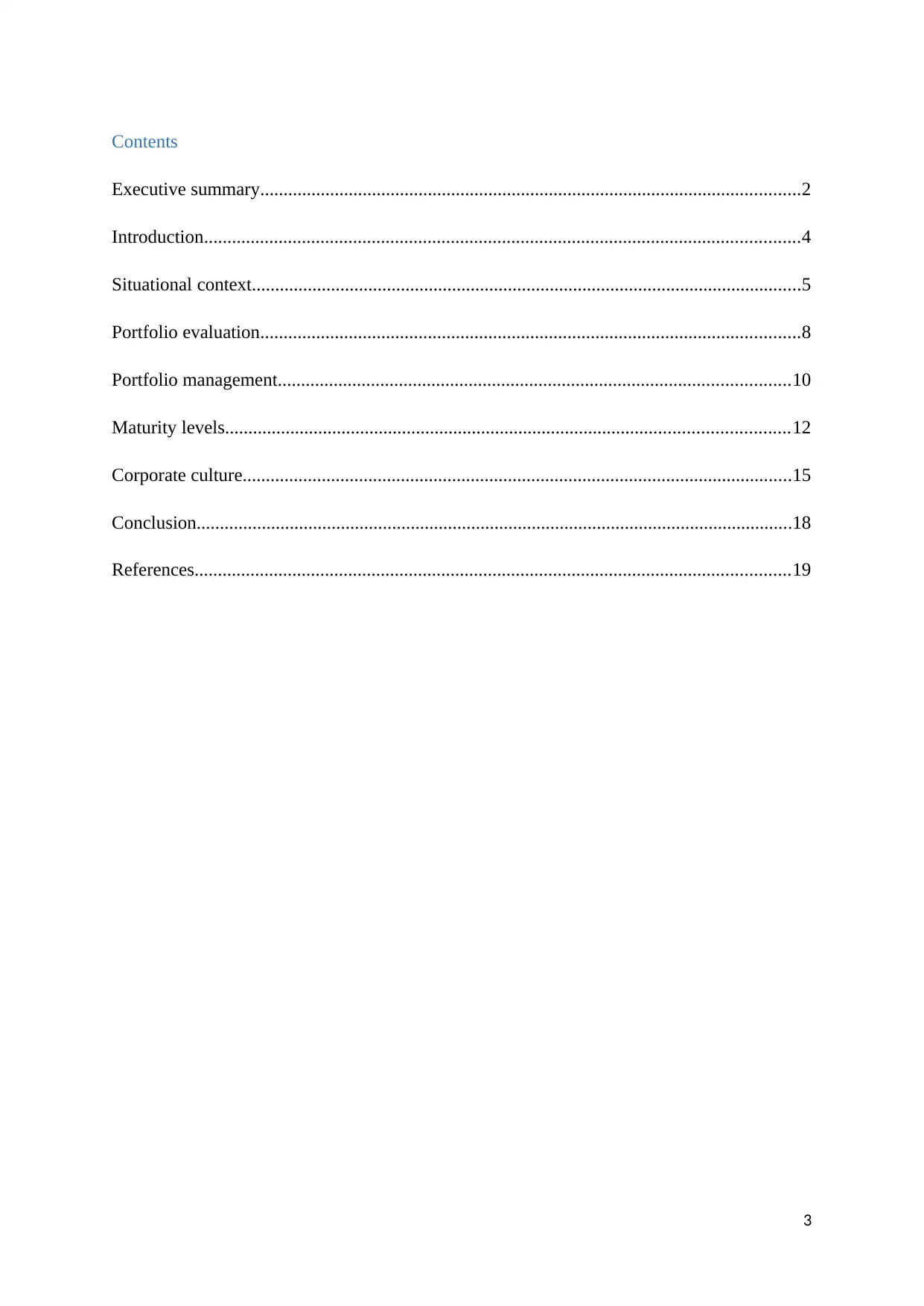
Contents
Executive summary....................................................................................................................2
Introduction................................................................................................................................4
Situational context......................................................................................................................5
Portfolio evaluation....................................................................................................................8
Portfolio management..............................................................................................................10
Maturity levels.........................................................................................................................12
Corporate culture......................................................................................................................15
Conclusion................................................................................................................................18
References................................................................................................................................19
3
Executive summary....................................................................................................................2
Introduction................................................................................................................................4
Situational context......................................................................................................................5
Portfolio evaluation....................................................................................................................8
Portfolio management..............................................................................................................10
Maturity levels.........................................................................................................................12
Corporate culture......................................................................................................................15
Conclusion................................................................................................................................18
References................................................................................................................................19
3
⊘ This is a preview!⊘
Do you want full access?
Subscribe today to unlock all pages.

Trusted by 1+ million students worldwide
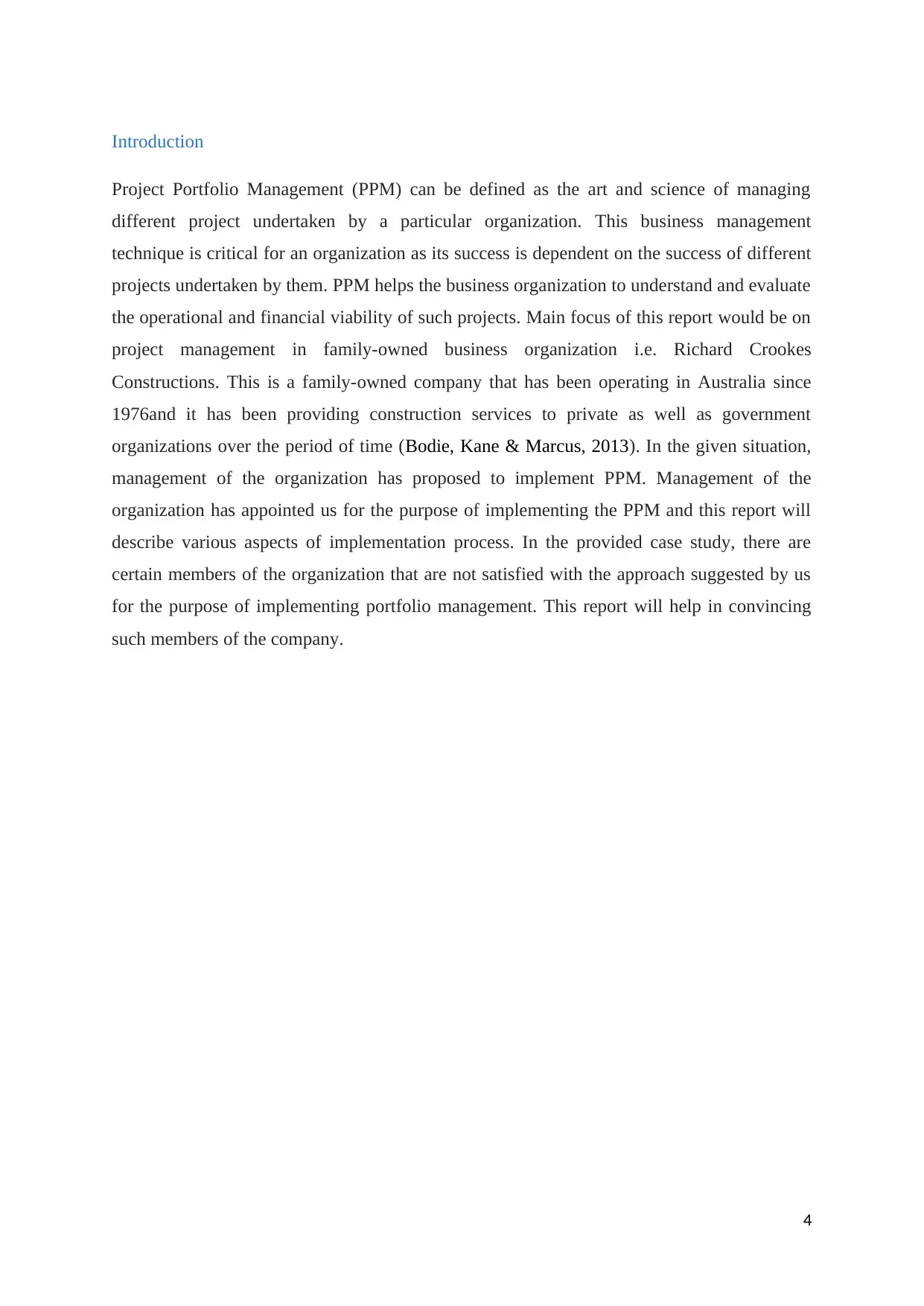
Introduction
Project Portfolio Management (PPM) can be defined as the art and science of managing
different project undertaken by a particular organization. This business management
technique is critical for an organization as its success is dependent on the success of different
projects undertaken by them. PPM helps the business organization to understand and evaluate
the operational and financial viability of such projects. Main focus of this report would be on
project management in family-owned business organization i.e. Richard Crookes
Constructions. This is a family-owned company that has been operating in Australia since
1976and it has been providing construction services to private as well as government
organizations over the period of time (Bodie, Kane & Marcus, 2013). In the given situation,
management of the organization has proposed to implement PPM. Management of the
organization has appointed us for the purpose of implementing the PPM and this report will
describe various aspects of implementation process. In the provided case study, there are
certain members of the organization that are not satisfied with the approach suggested by us
for the purpose of implementing portfolio management. This report will help in convincing
such members of the company.
4
Project Portfolio Management (PPM) can be defined as the art and science of managing
different project undertaken by a particular organization. This business management
technique is critical for an organization as its success is dependent on the success of different
projects undertaken by them. PPM helps the business organization to understand and evaluate
the operational and financial viability of such projects. Main focus of this report would be on
project management in family-owned business organization i.e. Richard Crookes
Constructions. This is a family-owned company that has been operating in Australia since
1976and it has been providing construction services to private as well as government
organizations over the period of time (Bodie, Kane & Marcus, 2013). In the given situation,
management of the organization has proposed to implement PPM. Management of the
organization has appointed us for the purpose of implementing the PPM and this report will
describe various aspects of implementation process. In the provided case study, there are
certain members of the organization that are not satisfied with the approach suggested by us
for the purpose of implementing portfolio management. This report will help in convincing
such members of the company.
4
Paraphrase This Document
Need a fresh take? Get an instant paraphrase of this document with our AI Paraphraser
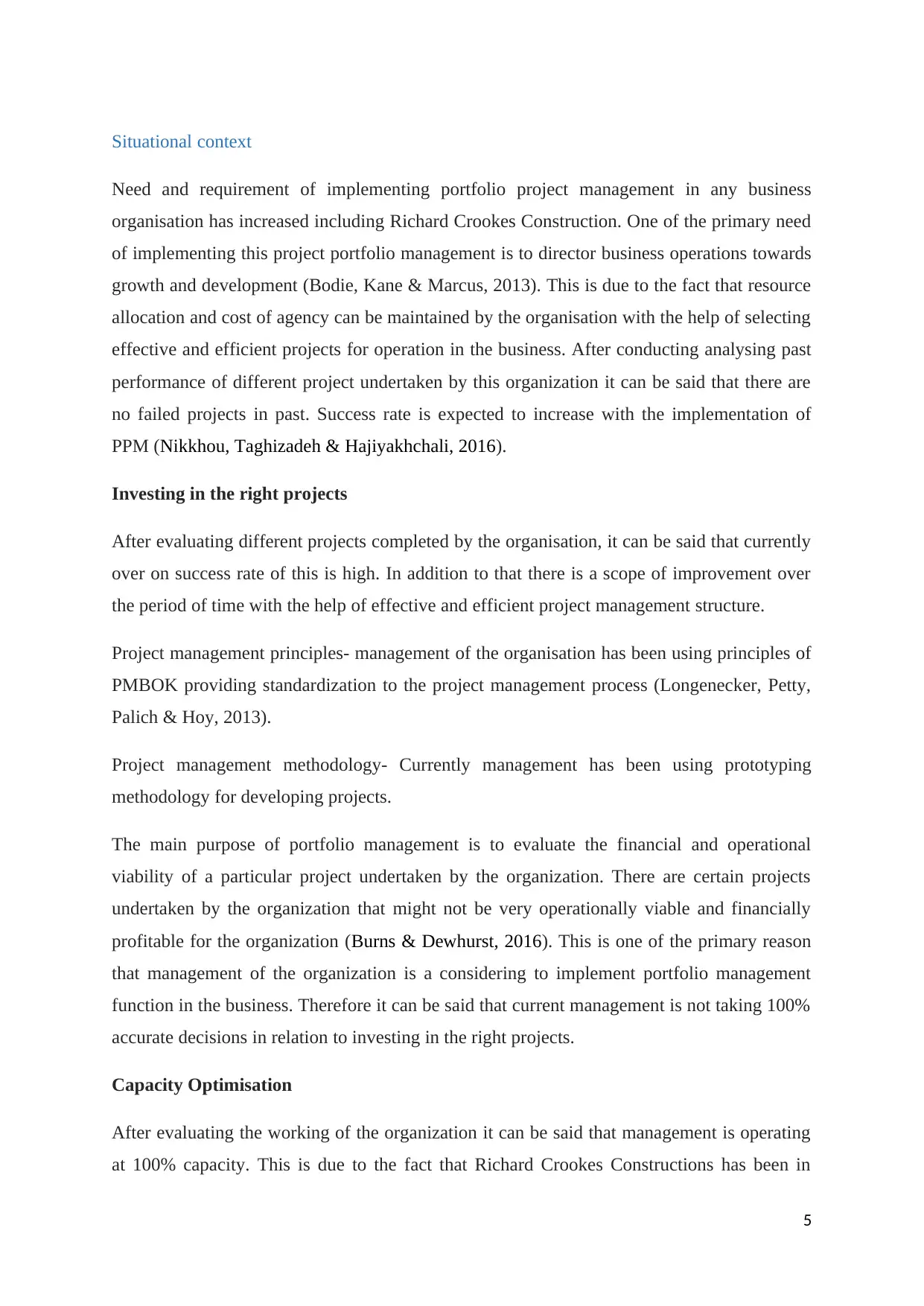
Situational context
Need and requirement of implementing portfolio project management in any business
organisation has increased including Richard Crookes Construction. One of the primary need
of implementing this project portfolio management is to director business operations towards
growth and development (Bodie, Kane & Marcus, 2013). This is due to the fact that resource
allocation and cost of agency can be maintained by the organisation with the help of selecting
effective and efficient projects for operation in the business. After conducting analysing past
performance of different project undertaken by this organization it can be said that there are
no failed projects in past. Success rate is expected to increase with the implementation of
PPM (Nikkhou, Taghizadeh & Hajiyakhchali, 2016).
Investing in the right projects
After evaluating different projects completed by the organisation, it can be said that currently
over on success rate of this is high. In addition to that there is a scope of improvement over
the period of time with the help of effective and efficient project management structure.
Project management principles- management of the organisation has been using principles of
PMBOK providing standardization to the project management process (Longenecker, Petty,
Palich & Hoy, 2013).
Project management methodology- Currently management has been using prototyping
methodology for developing projects.
The main purpose of portfolio management is to evaluate the financial and operational
viability of a particular project undertaken by the organization. There are certain projects
undertaken by the organization that might not be very operationally viable and financially
profitable for the organization (Burns & Dewhurst, 2016). This is one of the primary reason
that management of the organization is a considering to implement portfolio management
function in the business. Therefore it can be said that current management is not taking 100%
accurate decisions in relation to investing in the right projects.
Capacity Optimisation
After evaluating the working of the organization it can be said that management is operating
at 100% capacity. This is due to the fact that Richard Crookes Constructions has been in
5
Need and requirement of implementing portfolio project management in any business
organisation has increased including Richard Crookes Construction. One of the primary need
of implementing this project portfolio management is to director business operations towards
growth and development (Bodie, Kane & Marcus, 2013). This is due to the fact that resource
allocation and cost of agency can be maintained by the organisation with the help of selecting
effective and efficient projects for operation in the business. After conducting analysing past
performance of different project undertaken by this organization it can be said that there are
no failed projects in past. Success rate is expected to increase with the implementation of
PPM (Nikkhou, Taghizadeh & Hajiyakhchali, 2016).
Investing in the right projects
After evaluating different projects completed by the organisation, it can be said that currently
over on success rate of this is high. In addition to that there is a scope of improvement over
the period of time with the help of effective and efficient project management structure.
Project management principles- management of the organisation has been using principles of
PMBOK providing standardization to the project management process (Longenecker, Petty,
Palich & Hoy, 2013).
Project management methodology- Currently management has been using prototyping
methodology for developing projects.
The main purpose of portfolio management is to evaluate the financial and operational
viability of a particular project undertaken by the organization. There are certain projects
undertaken by the organization that might not be very operationally viable and financially
profitable for the organization (Burns & Dewhurst, 2016). This is one of the primary reason
that management of the organization is a considering to implement portfolio management
function in the business. Therefore it can be said that current management is not taking 100%
accurate decisions in relation to investing in the right projects.
Capacity Optimisation
After evaluating the working of the organization it can be said that management is operating
at 100% capacity. This is due to the fact that Richard Crookes Constructions has been in
5
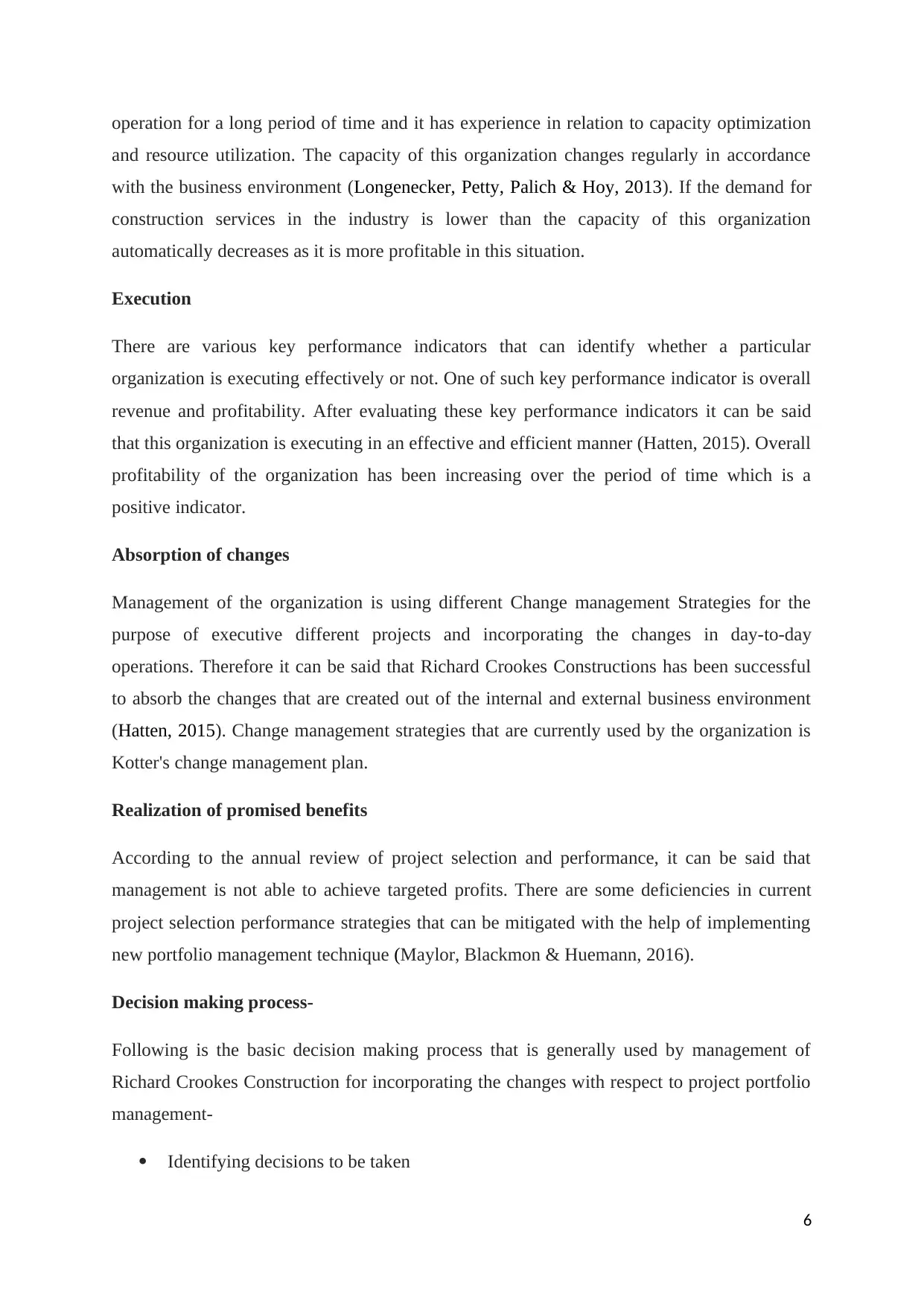
operation for a long period of time and it has experience in relation to capacity optimization
and resource utilization. The capacity of this organization changes regularly in accordance
with the business environment (Longenecker, Petty, Palich & Hoy, 2013). If the demand for
construction services in the industry is lower than the capacity of this organization
automatically decreases as it is more profitable in this situation.
Execution
There are various key performance indicators that can identify whether a particular
organization is executing effectively or not. One of such key performance indicator is overall
revenue and profitability. After evaluating these key performance indicators it can be said
that this organization is executing in an effective and efficient manner (Hatten, 2015). Overall
profitability of the organization has been increasing over the period of time which is a
positive indicator.
Absorption of changes
Management of the organization is using different Change management Strategies for the
purpose of executive different projects and incorporating the changes in day-to-day
operations. Therefore it can be said that Richard Crookes Constructions has been successful
to absorb the changes that are created out of the internal and external business environment
(Hatten, 2015). Change management strategies that are currently used by the organization is
Kotter's change management plan.
Realization of promised benefits
According to the annual review of project selection and performance, it can be said that
management is not able to achieve targeted profits. There are some deficiencies in current
project selection performance strategies that can be mitigated with the help of implementing
new portfolio management technique (Maylor, Blackmon & Huemann, 2016).
Decision making process-
Following is the basic decision making process that is generally used by management of
Richard Crookes Construction for incorporating the changes with respect to project portfolio
management-
Identifying decisions to be taken
6
and resource utilization. The capacity of this organization changes regularly in accordance
with the business environment (Longenecker, Petty, Palich & Hoy, 2013). If the demand for
construction services in the industry is lower than the capacity of this organization
automatically decreases as it is more profitable in this situation.
Execution
There are various key performance indicators that can identify whether a particular
organization is executing effectively or not. One of such key performance indicator is overall
revenue and profitability. After evaluating these key performance indicators it can be said
that this organization is executing in an effective and efficient manner (Hatten, 2015). Overall
profitability of the organization has been increasing over the period of time which is a
positive indicator.
Absorption of changes
Management of the organization is using different Change management Strategies for the
purpose of executive different projects and incorporating the changes in day-to-day
operations. Therefore it can be said that Richard Crookes Constructions has been successful
to absorb the changes that are created out of the internal and external business environment
(Hatten, 2015). Change management strategies that are currently used by the organization is
Kotter's change management plan.
Realization of promised benefits
According to the annual review of project selection and performance, it can be said that
management is not able to achieve targeted profits. There are some deficiencies in current
project selection performance strategies that can be mitigated with the help of implementing
new portfolio management technique (Maylor, Blackmon & Huemann, 2016).
Decision making process-
Following is the basic decision making process that is generally used by management of
Richard Crookes Construction for incorporating the changes with respect to project portfolio
management-
Identifying decisions to be taken
6
⊘ This is a preview!⊘
Do you want full access?
Subscribe today to unlock all pages.

Trusted by 1+ million students worldwide
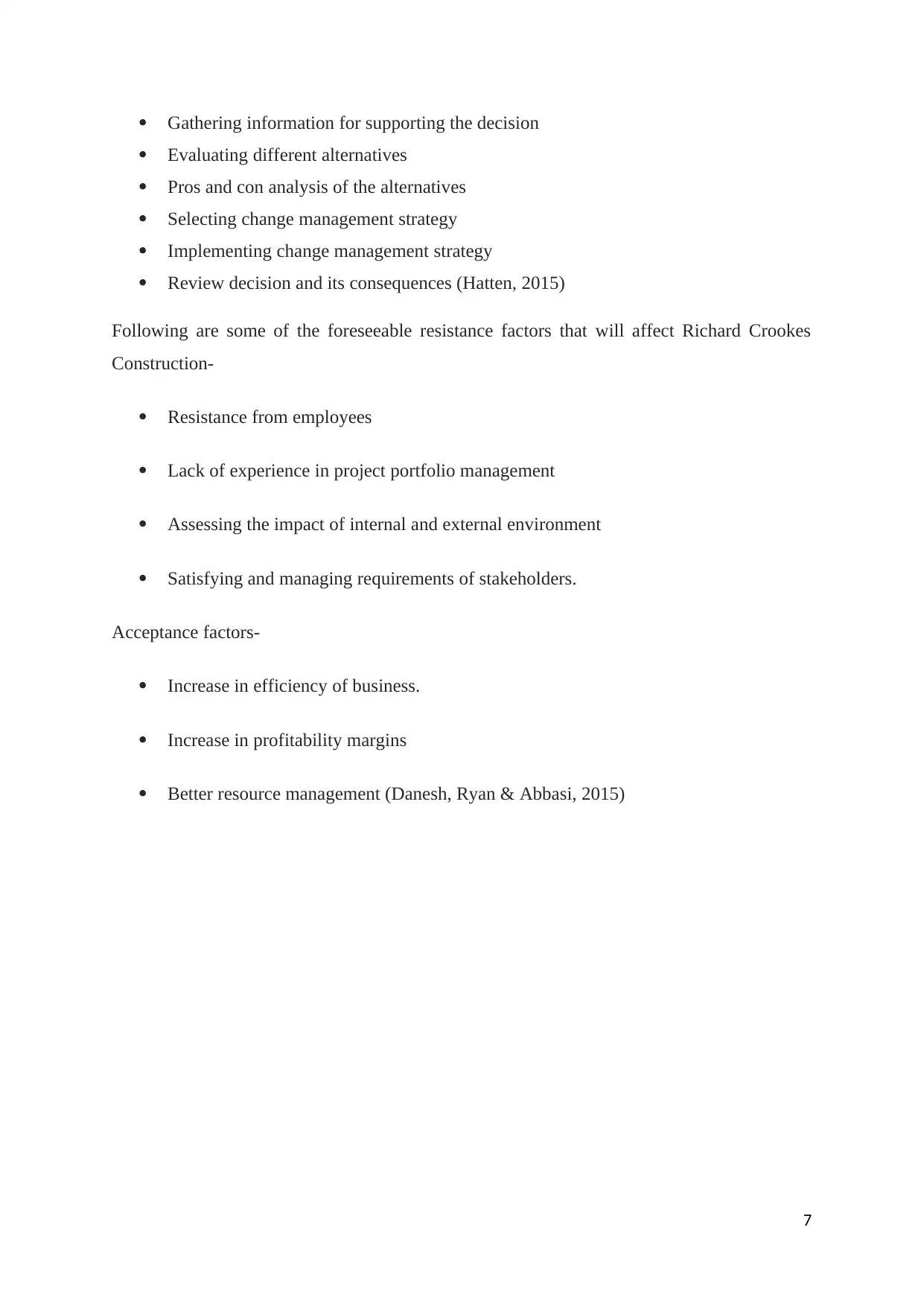
Gathering information for supporting the decision
Evaluating different alternatives
Pros and con analysis of the alternatives
Selecting change management strategy
Implementing change management strategy
Review decision and its consequences (Hatten, 2015)
Following are some of the foreseeable resistance factors that will affect Richard Crookes
Construction-
Resistance from employees
Lack of experience in project portfolio management
Assessing the impact of internal and external environment
Satisfying and managing requirements of stakeholders.
Acceptance factors-
Increase in efficiency of business.
Increase in profitability margins
Better resource management (Danesh, Ryan & Abbasi, 2015)
7
Evaluating different alternatives
Pros and con analysis of the alternatives
Selecting change management strategy
Implementing change management strategy
Review decision and its consequences (Hatten, 2015)
Following are some of the foreseeable resistance factors that will affect Richard Crookes
Construction-
Resistance from employees
Lack of experience in project portfolio management
Assessing the impact of internal and external environment
Satisfying and managing requirements of stakeholders.
Acceptance factors-
Increase in efficiency of business.
Increase in profitability margins
Better resource management (Danesh, Ryan & Abbasi, 2015)
7
Paraphrase This Document
Need a fresh take? Get an instant paraphrase of this document with our AI Paraphraser
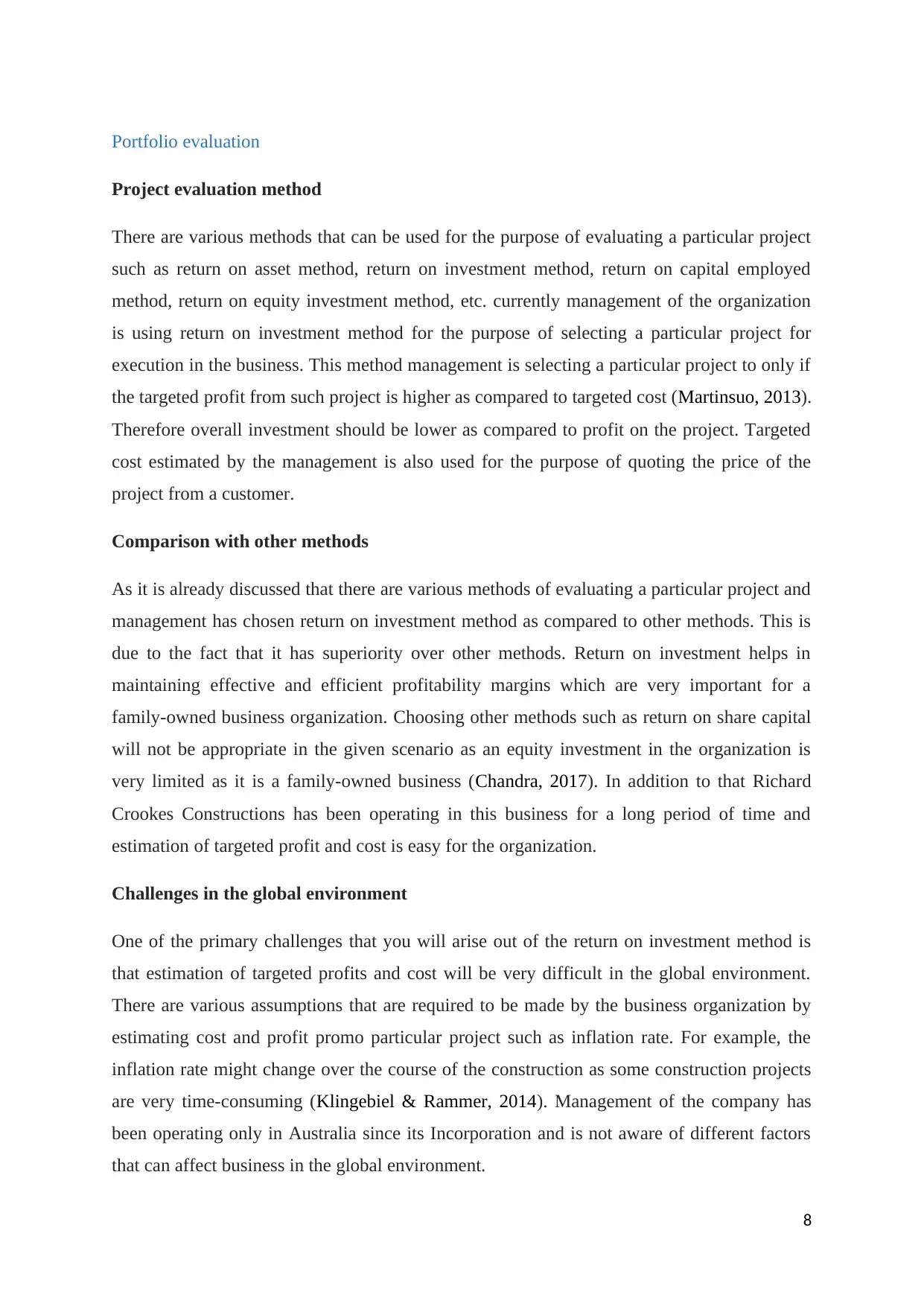
Portfolio evaluation
Project evaluation method
There are various methods that can be used for the purpose of evaluating a particular project
such as return on asset method, return on investment method, return on capital employed
method, return on equity investment method, etc. currently management of the organization
is using return on investment method for the purpose of selecting a particular project for
execution in the business. This method management is selecting a particular project to only if
the targeted profit from such project is higher as compared to targeted cost (Martinsuo, 2013).
Therefore overall investment should be lower as compared to profit on the project. Targeted
cost estimated by the management is also used for the purpose of quoting the price of the
project from a customer.
Comparison with other methods
As it is already discussed that there are various methods of evaluating a particular project and
management has chosen return on investment method as compared to other methods. This is
due to the fact that it has superiority over other methods. Return on investment helps in
maintaining effective and efficient profitability margins which are very important for a
family-owned business organization. Choosing other methods such as return on share capital
will not be appropriate in the given scenario as an equity investment in the organization is
very limited as it is a family-owned business (Chandra, 2017). In addition to that Richard
Crookes Constructions has been operating in this business for a long period of time and
estimation of targeted profit and cost is easy for the organization.
Challenges in the global environment
One of the primary challenges that you will arise out of the return on investment method is
that estimation of targeted profits and cost will be very difficult in the global environment.
There are various assumptions that are required to be made by the business organization by
estimating cost and profit promo particular project such as inflation rate. For example, the
inflation rate might change over the course of the construction as some construction projects
are very time-consuming (Klingebiel & Rammer, 2014). Management of the company has
been operating only in Australia since its Incorporation and is not aware of different factors
that can affect business in the global environment.
8
Project evaluation method
There are various methods that can be used for the purpose of evaluating a particular project
such as return on asset method, return on investment method, return on capital employed
method, return on equity investment method, etc. currently management of the organization
is using return on investment method for the purpose of selecting a particular project for
execution in the business. This method management is selecting a particular project to only if
the targeted profit from such project is higher as compared to targeted cost (Martinsuo, 2013).
Therefore overall investment should be lower as compared to profit on the project. Targeted
cost estimated by the management is also used for the purpose of quoting the price of the
project from a customer.
Comparison with other methods
As it is already discussed that there are various methods of evaluating a particular project and
management has chosen return on investment method as compared to other methods. This is
due to the fact that it has superiority over other methods. Return on investment helps in
maintaining effective and efficient profitability margins which are very important for a
family-owned business organization. Choosing other methods such as return on share capital
will not be appropriate in the given scenario as an equity investment in the organization is
very limited as it is a family-owned business (Chandra, 2017). In addition to that Richard
Crookes Constructions has been operating in this business for a long period of time and
estimation of targeted profit and cost is easy for the organization.
Challenges in the global environment
One of the primary challenges that you will arise out of the return on investment method is
that estimation of targeted profits and cost will be very difficult in the global environment.
There are various assumptions that are required to be made by the business organization by
estimating cost and profit promo particular project such as inflation rate. For example, the
inflation rate might change over the course of the construction as some construction projects
are very time-consuming (Klingebiel & Rammer, 2014). Management of the company has
been operating only in Australia since its Incorporation and is not aware of different factors
that can affect business in the global environment.
8
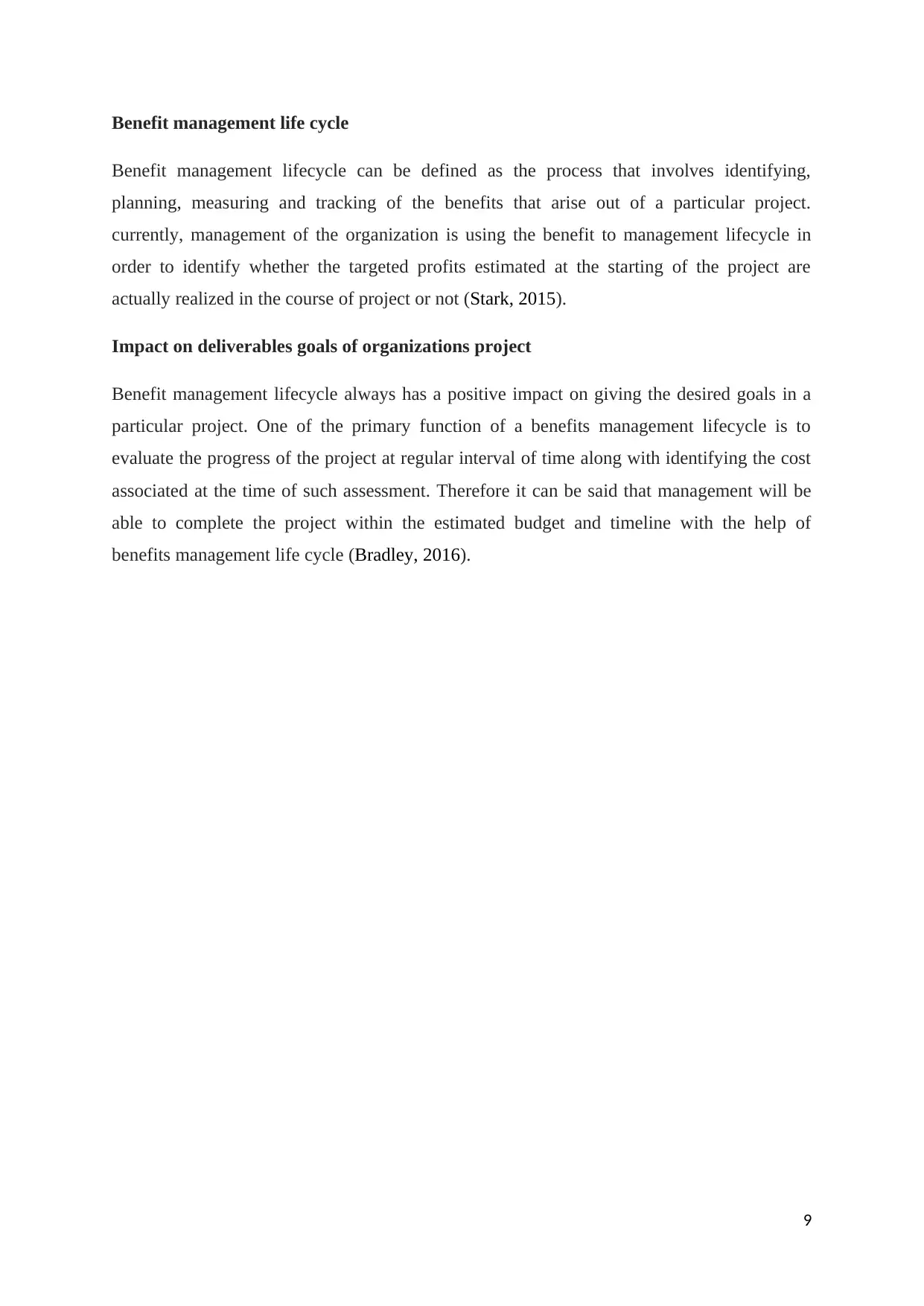
Benefit management life cycle
Benefit management lifecycle can be defined as the process that involves identifying,
planning, measuring and tracking of the benefits that arise out of a particular project.
currently, management of the organization is using the benefit to management lifecycle in
order to identify whether the targeted profits estimated at the starting of the project are
actually realized in the course of project or not (Stark, 2015).
Impact on deliverables goals of organizations project
Benefit management lifecycle always has a positive impact on giving the desired goals in a
particular project. One of the primary function of a benefits management lifecycle is to
evaluate the progress of the project at regular interval of time along with identifying the cost
associated at the time of such assessment. Therefore it can be said that management will be
able to complete the project within the estimated budget and timeline with the help of
benefits management life cycle (Bradley, 2016).
9
Benefit management lifecycle can be defined as the process that involves identifying,
planning, measuring and tracking of the benefits that arise out of a particular project.
currently, management of the organization is using the benefit to management lifecycle in
order to identify whether the targeted profits estimated at the starting of the project are
actually realized in the course of project or not (Stark, 2015).
Impact on deliverables goals of organizations project
Benefit management lifecycle always has a positive impact on giving the desired goals in a
particular project. One of the primary function of a benefits management lifecycle is to
evaluate the progress of the project at regular interval of time along with identifying the cost
associated at the time of such assessment. Therefore it can be said that management will be
able to complete the project within the estimated budget and timeline with the help of
benefits management life cycle (Bradley, 2016).
9
⊘ This is a preview!⊘
Do you want full access?
Subscribe today to unlock all pages.

Trusted by 1+ million students worldwide
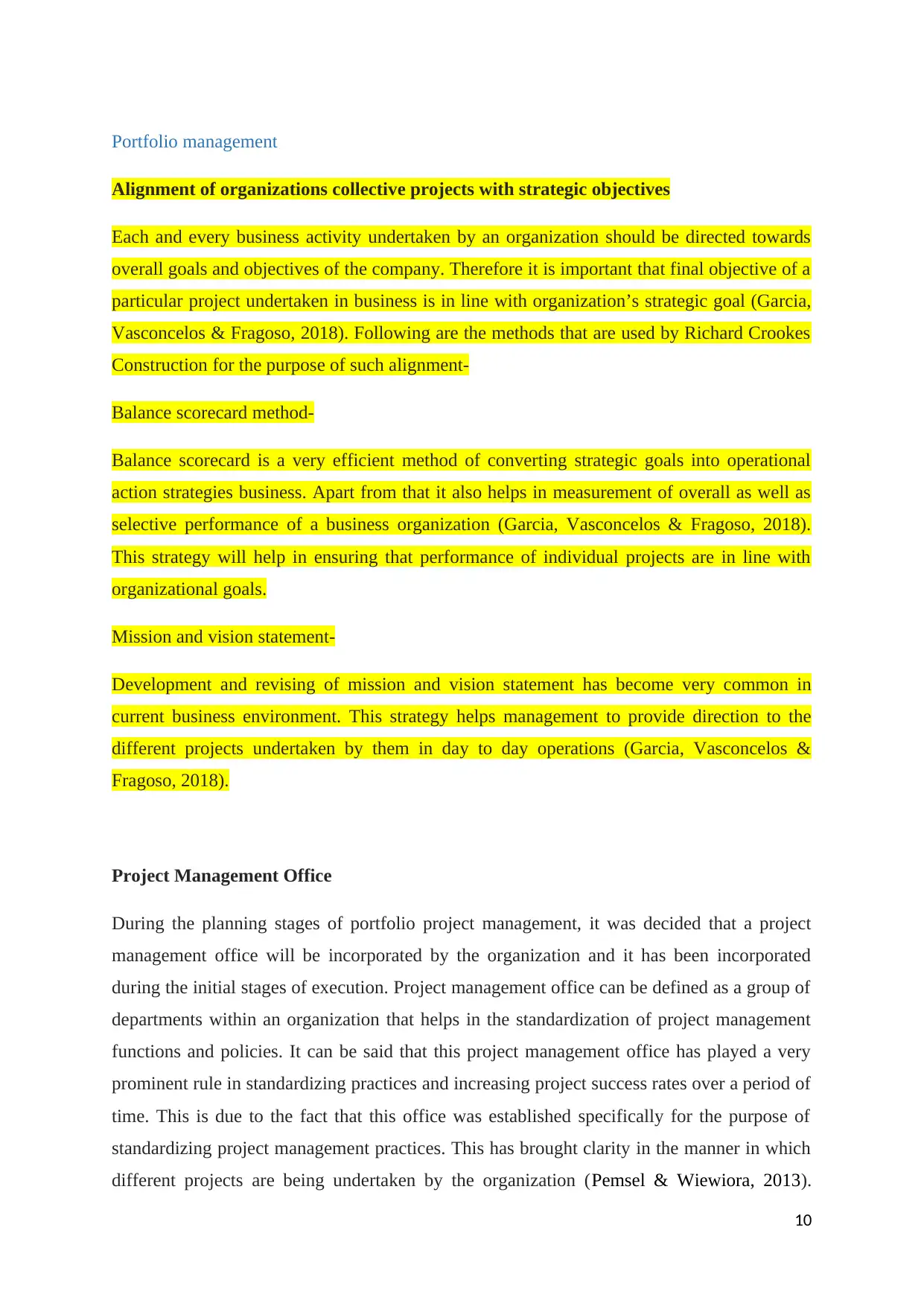
Portfolio management
Alignment of organizations collective projects with strategic objectives
Each and every business activity undertaken by an organization should be directed towards
overall goals and objectives of the company. Therefore it is important that final objective of a
particular project undertaken in business is in line with organization’s strategic goal (Garcia,
Vasconcelos & Fragoso, 2018). Following are the methods that are used by Richard Crookes
Construction for the purpose of such alignment-
Balance scorecard method-
Balance scorecard is a very efficient method of converting strategic goals into operational
action strategies business. Apart from that it also helps in measurement of overall as well as
selective performance of a business organization (Garcia, Vasconcelos & Fragoso, 2018).
This strategy will help in ensuring that performance of individual projects are in line with
organizational goals.
Mission and vision statement-
Development and revising of mission and vision statement has become very common in
current business environment. This strategy helps management to provide direction to the
different projects undertaken by them in day to day operations (Garcia, Vasconcelos &
Fragoso, 2018).
Project Management Office
During the planning stages of portfolio project management, it was decided that a project
management office will be incorporated by the organization and it has been incorporated
during the initial stages of execution. Project management office can be defined as a group of
departments within an organization that helps in the standardization of project management
functions and policies. It can be said that this project management office has played a very
prominent rule in standardizing practices and increasing project success rates over a period of
time. This is due to the fact that this office was established specifically for the purpose of
standardizing project management practices. This has brought clarity in the manner in which
different projects are being undertaken by the organization (Pemsel & Wiewiora, 2013).
10
Alignment of organizations collective projects with strategic objectives
Each and every business activity undertaken by an organization should be directed towards
overall goals and objectives of the company. Therefore it is important that final objective of a
particular project undertaken in business is in line with organization’s strategic goal (Garcia,
Vasconcelos & Fragoso, 2018). Following are the methods that are used by Richard Crookes
Construction for the purpose of such alignment-
Balance scorecard method-
Balance scorecard is a very efficient method of converting strategic goals into operational
action strategies business. Apart from that it also helps in measurement of overall as well as
selective performance of a business organization (Garcia, Vasconcelos & Fragoso, 2018).
This strategy will help in ensuring that performance of individual projects are in line with
organizational goals.
Mission and vision statement-
Development and revising of mission and vision statement has become very common in
current business environment. This strategy helps management to provide direction to the
different projects undertaken by them in day to day operations (Garcia, Vasconcelos &
Fragoso, 2018).
Project Management Office
During the planning stages of portfolio project management, it was decided that a project
management office will be incorporated by the organization and it has been incorporated
during the initial stages of execution. Project management office can be defined as a group of
departments within an organization that helps in the standardization of project management
functions and policies. It can be said that this project management office has played a very
prominent rule in standardizing practices and increasing project success rates over a period of
time. This is due to the fact that this office was established specifically for the purpose of
standardizing project management practices. This has brought clarity in the manner in which
different projects are being undertaken by the organization (Pemsel & Wiewiora, 2013).
10
Paraphrase This Document
Need a fresh take? Get an instant paraphrase of this document with our AI Paraphraser
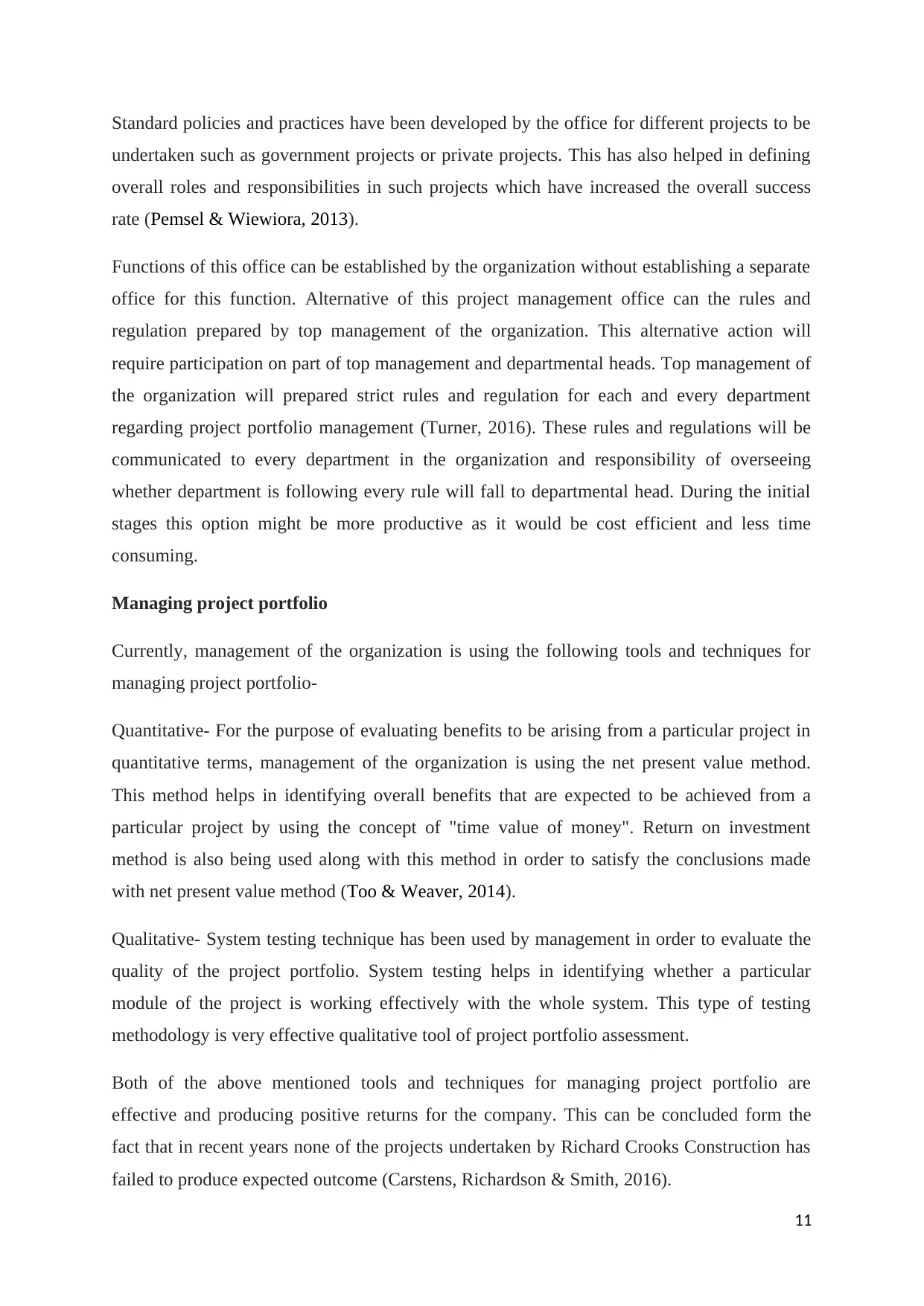
Standard policies and practices have been developed by the office for different projects to be
undertaken such as government projects or private projects. This has also helped in defining
overall roles and responsibilities in such projects which have increased the overall success
rate (Pemsel & Wiewiora, 2013).
Functions of this office can be established by the organization without establishing a separate
office for this function. Alternative of this project management office can the rules and
regulation prepared by top management of the organization. This alternative action will
require participation on part of top management and departmental heads. Top management of
the organization will prepared strict rules and regulation for each and every department
regarding project portfolio management (Turner, 2016). These rules and regulations will be
communicated to every department in the organization and responsibility of overseeing
whether department is following every rule will fall to departmental head. During the initial
stages this option might be more productive as it would be cost efficient and less time
consuming.
Managing project portfolio
Currently, management of the organization is using the following tools and techniques for
managing project portfolio-
Quantitative- For the purpose of evaluating benefits to be arising from a particular project in
quantitative terms, management of the organization is using the net present value method.
This method helps in identifying overall benefits that are expected to be achieved from a
particular project by using the concept of "time value of money". Return on investment
method is also being used along with this method in order to satisfy the conclusions made
with net present value method (Too & Weaver, 2014).
Qualitative- System testing technique has been used by management in order to evaluate the
quality of the project portfolio. System testing helps in identifying whether a particular
module of the project is working effectively with the whole system. This type of testing
methodology is very effective qualitative tool of project portfolio assessment.
Both of the above mentioned tools and techniques for managing project portfolio are
effective and producing positive returns for the company. This can be concluded form the
fact that in recent years none of the projects undertaken by Richard Crooks Construction has
failed to produce expected outcome (Carstens, Richardson & Smith, 2016).
11
undertaken such as government projects or private projects. This has also helped in defining
overall roles and responsibilities in such projects which have increased the overall success
rate (Pemsel & Wiewiora, 2013).
Functions of this office can be established by the organization without establishing a separate
office for this function. Alternative of this project management office can the rules and
regulation prepared by top management of the organization. This alternative action will
require participation on part of top management and departmental heads. Top management of
the organization will prepared strict rules and regulation for each and every department
regarding project portfolio management (Turner, 2016). These rules and regulations will be
communicated to every department in the organization and responsibility of overseeing
whether department is following every rule will fall to departmental head. During the initial
stages this option might be more productive as it would be cost efficient and less time
consuming.
Managing project portfolio
Currently, management of the organization is using the following tools and techniques for
managing project portfolio-
Quantitative- For the purpose of evaluating benefits to be arising from a particular project in
quantitative terms, management of the organization is using the net present value method.
This method helps in identifying overall benefits that are expected to be achieved from a
particular project by using the concept of "time value of money". Return on investment
method is also being used along with this method in order to satisfy the conclusions made
with net present value method (Too & Weaver, 2014).
Qualitative- System testing technique has been used by management in order to evaluate the
quality of the project portfolio. System testing helps in identifying whether a particular
module of the project is working effectively with the whole system. This type of testing
methodology is very effective qualitative tool of project portfolio assessment.
Both of the above mentioned tools and techniques for managing project portfolio are
effective and producing positive returns for the company. This can be concluded form the
fact that in recent years none of the projects undertaken by Richard Crooks Construction has
failed to produce expected outcome (Carstens, Richardson & Smith, 2016).
11
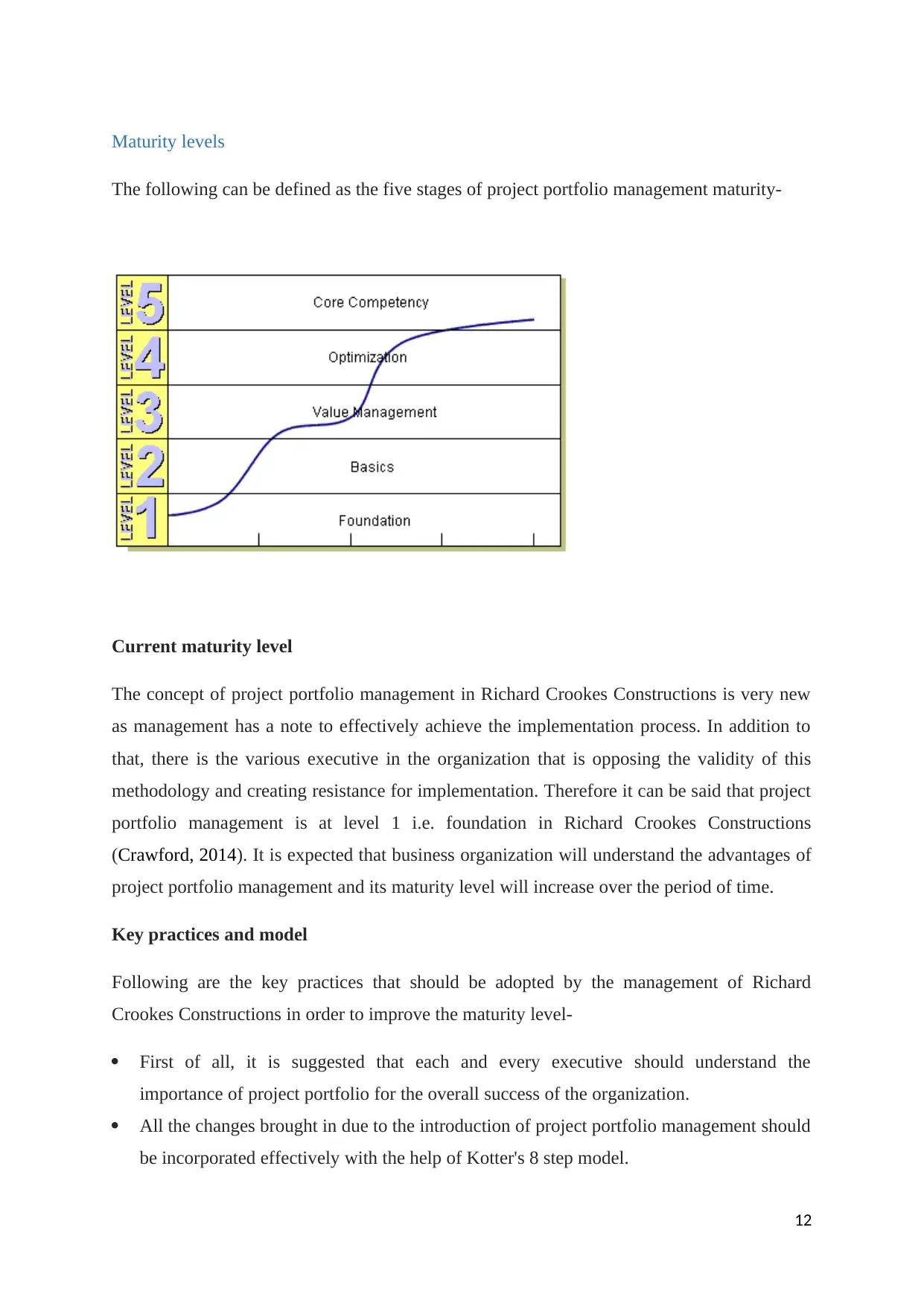
Maturity levels
The following can be defined as the five stages of project portfolio management maturity-
Current maturity level
The concept of project portfolio management in Richard Crookes Constructions is very new
as management has a note to effectively achieve the implementation process. In addition to
that, there is the various executive in the organization that is opposing the validity of this
methodology and creating resistance for implementation. Therefore it can be said that project
portfolio management is at level 1 i.e. foundation in Richard Crookes Constructions
(Crawford, 2014). It is expected that business organization will understand the advantages of
project portfolio management and its maturity level will increase over the period of time.
Key practices and model
Following are the key practices that should be adopted by the management of Richard
Crookes Constructions in order to improve the maturity level-
First of all, it is suggested that each and every executive should understand the
importance of project portfolio for the overall success of the organization.
All the changes brought in due to the introduction of project portfolio management should
be incorporated effectively with the help of Kotter's 8 step model.
12
The following can be defined as the five stages of project portfolio management maturity-
Current maturity level
The concept of project portfolio management in Richard Crookes Constructions is very new
as management has a note to effectively achieve the implementation process. In addition to
that, there is the various executive in the organization that is opposing the validity of this
methodology and creating resistance for implementation. Therefore it can be said that project
portfolio management is at level 1 i.e. foundation in Richard Crookes Constructions
(Crawford, 2014). It is expected that business organization will understand the advantages of
project portfolio management and its maturity level will increase over the period of time.
Key practices and model
Following are the key practices that should be adopted by the management of Richard
Crookes Constructions in order to improve the maturity level-
First of all, it is suggested that each and every executive should understand the
importance of project portfolio for the overall success of the organization.
All the changes brought in due to the introduction of project portfolio management should
be incorporated effectively with the help of Kotter's 8 step model.
12
⊘ This is a preview!⊘
Do you want full access?
Subscribe today to unlock all pages.

Trusted by 1+ million students worldwide
1 out of 21
Related Documents
Your All-in-One AI-Powered Toolkit for Academic Success.
+13062052269
info@desklib.com
Available 24*7 on WhatsApp / Email
![[object Object]](/_next/static/media/star-bottom.7253800d.svg)
Unlock your academic potential
Copyright © 2020–2025 A2Z Services. All Rights Reserved. Developed and managed by ZUCOL.




